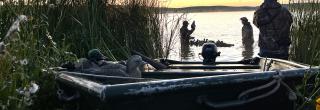
Boating Safety for Hunters
State Laws
- All boats must have a U.S. Coast Guard approved wearable personal flotation device for each occupant, and those boats over 16 feet in length must also have a U.S. Coast Guard approved throwable personal flotation device. Boat occupants age 10 and under must wear their life jacket while the boat is in operation.
- No person 12 through 15 years of age may operate a motorboat or personal watercraft propelled by a motor of more than 10 horsepower unless the operator is accompanied by a person 18 years of age or older, or the operator has taken and passed a Department approved boating course.
- For a complete list of boating regulations in North Dakota, contact the Game and Fish Department.
Boating Tips for Hunters
- Life jackets save lives. Wear it, don’t just bring it!
- Cold water immersion is life threatening. Dress for the water temperature, not the air temperature.
- Do not operate vessels in overloaded conditions. Sudden shifts in weight by dogs or hunters can result in capsizing.
- Check the weather to avoid encountering conditions that exceed your skills or boat capabilities.
- Introduce your dog to hunting from a boat prior to hunting season.
- Carry a cell phone or emergency beacon and avoid hunting alone.
- File a float plan and always tell someone when you plan to return.
Life Jackets for Hunters
Life jackets are available in a wide variety of styles and colors that meet the demands of hunters.
Life jackets can increase survival time because of the insulation they provide.
Naturally, the warmer the water the less insulation one will require.
When operating in cold waters (below 40 degrees F) consideration should be given to using a coat or jacket-style as they cover more of the body than the vest-style.
Hypothermia and Waterfowl Hunters
Hypothermia, the loss of body heat to the water, is probably the greatest cause of water-related deaths.
Often the cause of death is listed as drowning; but, most often the primary cause is hypothermia and the secondary cause is drowning.
After an individual has succumbed to hypothermia, he/she will lose consciousness and then drown.
Effects of Hypothermia
| Water Temperature (F °) | Exhaustion or Unconsciousness | Expected Survival Time |
|---|---|---|
| 32.5 | Under 15 minutes | Under 15 to 45 minutes |
| 32.5 to 40 | 15 to 30 minutes | 30 to 90 minutes |
| 40 to 50 | 30 to 60 minutes | 1 to 3 hours |
| 50 to 60 | 1 to 2 hours | 1 to 6 hours |
| 60 to 70 | 2 to 7 hours | 2 to 40 hours |
| 70 to 80 | 3 to 12 hours | 3 hours to indefinitely |
| Over 80 | Indefinitely | Indefinitely |
